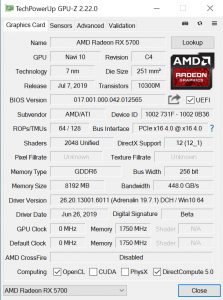
July 7 marks a busy day for AMD, as it releases not only its new 7nm Ryzen 3000 processors, but two new 7nm graphics cards as well – the Radeon RX 5700 and RX 5700 XT. Built on the new RDNA architecture, these cards are AMD's attempt to win back the mid-range market segment after its Radeon VII GPU wasn't able to topple Nvidia's RTX 2080 in the high-end earlier this year.
In this review we are focusing on the $349 RX 5700, but we also have a full review of the RX 5700 XT over here if you are interested. Going head to head with Nvidia's RTX 2060, can the RX 5700 come out on top?
When AMD gave us our first good look at the new cards back at E3, the Radeon RX 5700 was compared to Nvidia's RTX 2060 and its performance looked compelling. As a preemptive strike, however, Nvidia recently launched its new RTX 2060 SUPER and RTX 2070 SUPER graphics cards, which both offer decent performance increases over the original models.
Adding a further twist to proceedings, AMD announced on Friday that it has actually dropped pricing of both its new cards ahead of launch. The RX 5700 is now priced at $349, and the 5700 XT costs at $399, throwing a real spanner in the works as the 5700 is now competing against the 2060, not the 2060 SUPER as Nvidia had anticipated.
| RX 5700 | RX 5700 XT | RX Vega 56 | RX Vega 64 | Radeon VII | |
| Architecture | Navi | Navi | Vega 10 | Vega 10 | Vega 20 |
| Manufacturing Process | 7nm | 7nm | 14nm | 14nm | 7nm |
| Transistor Count | 10.3 billion | 10.3 billion | 12.5 billion | 12.5 billion | 13.2 billion |
| Die Size | 251mm² | 251mm² | 486mm² | 495mm² | 331mm² |
| Compute Units | 36 | 40 | 56 | 64 | 60 |
| Stream Processors | 2304 | 2560 | 3584 | 4096 | 3840 |
| Base GPU Clock | Up to 1465MHz | Up to 1605MHz | 1156 MHz | 1274 MHz | 1400 MHz |
| Game GPU Clock | Up to 1625MHz | Up to 1755MHz | n/a | n/a | n/a |
| Boost GPU Clock | Up to 1725MHz | Up to 1905MHz | 1471 MHz | 1546 MHz | 1750 MHz |
| Peak Engine Clock | n/a | n/a | 1590 MHz | 1630 MHz | 1800 MHz |
| Peak SP Performance | Up to 7.95 TFLOPS | Up to 9.75 TFLOPS | Up to 10.5 TFLOPS | Up to 12.7 TFLOPS | Up to 14.2 TFLOPS |
| Peak Half Precision Performance | Up to 15.9 TFLOPS | Up to 19.5 TFLOPS | Up to 21.0 TFLOPS | Up to 25.3 TFLOPS | Up to 28.1 TFLOPS |
| Peak Texture Fill-Rate | Up to 248.4 GT/s | Up to 304.8 GT/s | Up to 330.0 GT/s | Up to 395.8 GT/s | 432.24 GT/s |
| ROPs | 64 | 64 | 64 | 64 | 64 |
| Peak Pixel Fill-Rate | Up to 110.4 GP/s | Up to 121.9 GP/s | Up to 94.0 GP/s | Up to 98.9 GP/s | 115.26 GP/s |
| Memory | 8GB GDDR6 | 8GB GDDR6 | 8GB HBM | 8GB HBM | 16GB HBM2 |
| Memory Bandwidth | 448 GB/s | 448 GB/s | 410 GB/s | 483.8 GB/s | 1 TB/s |
| Memory Interface | 256-bit | 256-bit | 2048-bit | 2048-bit | 4096-bit |
| Board Power | 185W | 225W | 210W | 295W | 300W |
Built on AMD's new RDNA architecture, the RX 5700 is the lesser of the two new Navi GPUs hitting the market. It sports 36 Compute Units (CUs), the design of which has been completely reworked for Navi, which is 4 less than its bigger brother, the RX 5700 XT. Each CU is home to 64 stream processors, therefore the RX 5700 has 2304 of those.
The Navi GPU is fabricated on TSMC's 7nm process, which not only means a physically smaller die size for both new cards – 251mm², versus 486mm² for Vega 56, for instance – but higher clock speeds as well. Base clock for the RX 5700 is rated at 1465MHz, with a boost of up to 1725MHz. Interestingly, AMD is also touting a new ‘game clock', the frequency which you can expect to see the card hit while gaming. For the RX 5700, its game clock is 1625MHz.
On top of these developments, Navi also marks AMD's shift away from High Bandwidth Memory (HBM), for its mid-range cards at least. Both RX 5700 and RX 5700 XT sport the latest GDDR6 memory, running at the same 14Gbps that we have become used to with Nvidia's RTX series of cards. Over a 256-bit bus, this provides 448 GB/s of memory bandwidth.
Lastly, total board power for the RX 5700 is rated at 185W. This is 10W than the rated Total Graphics Power (TGP) of the RTX 2060 SUPER.
 KitGuru KitGuru.net – Tech News | Hardware News | Hardware Reviews | IOS | Mobile | Gaming | Graphics Cards
KitGuru KitGuru.net – Tech News | Hardware News | Hardware Reviews | IOS | Mobile | Gaming | Graphics Cards




